The Historia Scholastica (circa 1170) mingles biblical narrative, Jewish legends, and commentary, and was a popular source of biblical material for authors until the Reformation. Maria Sherwood-Smith gives an introduction to the sources and transmission of the Latin work before investigating its reception in detail in two thirteenth-century German works, the Schwarzwälder Predigten and the Weltchronik of Rudolf von Ems. Briefer analyses of Jacob van Maerlant’s Scolastica and the Historiebijbel van 1360 provide further context. Looking in this way at the different functions the work fulfils for later authors, one discerns a growing awareness of the distinction between it and the text of the Bible. It is suggested that this enhances the Historia Scholastica’s reputation as a safeguard of orthodoxy.

